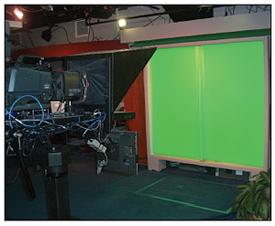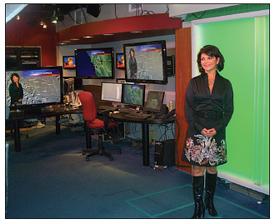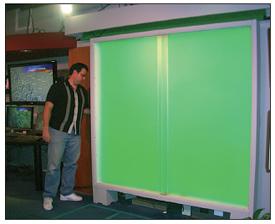Making Green 'Cool'
SAN FRANCISCO
Electroluminescence, a form of "cold light." has been available in commercial products for some 50 years now, but until very recently, never really made it into the broadcast arena. However, KPIX-TV, the San Francisco CBS O&O, has found a way to use it to solve a long-standing problem with newsroom weather chroma-key set.
"The camera is only five feet away, so backlighting of the traditional green screen was difficult and the talent often strayed into it, suddenly 'blooming' on camera," said Don McKinney, chief of studio operations at the station. "That area of the newsroom had only the same air conditioning as the rest of the room, so with the quartz lighting it would get extremely hot after only 10 minutes or so."
McKinney found an answer to the station's problems in the form of a lighting material produced by Ceelite, a Bluebell, Pa.-based developer of LEC technology, that is normally employed only for residential nightlights and street sign/instrument panel/digital wristwatch backlighting.

San Francisco's CBS 5 (KPIX-TV) has gone doubly "green" by replacing its conventional chroma-key green screen with self-illuminating material which consumes a negligible amount of electricity. Working with a low wattage lighting consultant from Los Angeles, they decided on a full-sized test of the screen. "This was the first time I had been introduced to the G-LEC self-illuminating product," said McKinney. "It's an emergent technology only recently considered for this application. It produces its own light, so there's no need to light the green screen, only the talent. We were able to get rid of about 2,400 watts of back and cyc light and now the talent can be right up against the key and even touch it."
LEC (light-emitting capacitor technology) is the basis for the cold lighting product used at the station. It's basically what its name implies—a capacitor that emits light without producing much heat. The material is manufactured by substituting a phosphor-containing insulator for the dielectric material ordinarily found in capacitors. And at least one of the capacitor electrodes must be transparent to allow the light photons to escape. Glass or clear plastic materials can be doped with indium, tin or other oxides to achieve the required conductivity and transparency. A metallic reflective material is ordinarily used for the rear capacitor electrode to increase the light output.
ADDING NEW MEANING TO 'GREEN'
According to McKinney, the electroluminescent panels being used are dimmable and consume a mere 50 watts of AC power when fully illuminated. The existing studio lighting package was also replaced with more emergency-efficient technology at the same time the self-illuminating electroluminescent green screen was installed, causing energy consumption and associated heating effects to plummet significantly.
"When I installed the LEC screen, I also replaced all of the quartz lights with RGB LED light bars and small LED backlights," McKinney said. "The studio area went from 4,200 watts to 700 watts—that's an 83 percent reduction in energy consumption."

Roberta Gonzales, the station's main anchor person, is one of several on-camera weathercasters who appreciate the reduced set temperatures resulting from the use of cold light technology. As the LEC material is fairly flexible, McKinney built a special frame constructed to rigidly mount the panels, and added a layer of Plexiglas to afford extra protection and slightly diffuse the light generated by the new light sources.
The material being used at KPIX is some of the largest currently available. McKinney was able to secure 3 x 6-foot LEC panels for his application, but is looking forward to even larger sheets of the material being made available. "Small light panels have been available for some time, but has been steadily increasing to size to the panels I used," he said. "Right now the panels have to be custom ordered and are limited to a three-foot width. I understand that the company is going to build a new plant here in the United States that can produce even larger sizes."
Are there any downsides to the new technology? McKinney doesn't seem to think so.
"It's really cool," he said. "We leave it on all day and it doesn't get hot. Our on-air talent are huge fans of the new set. Initially, they looked at it like 'what's that strange green thing,' but they quickly became converts, as there's no on-camera sweating anymore."
McKinney said that there's nothing special about the new light source. The panels he's using are equipped with a small inverter that's included to optimize the life of the gently glowing material, and to allow dimming and flashing. It also serves to electrically isolate the cold lights for safety purposes. Dim-out, or reduction of light output over time, has been one drawback with electroluminescent technology, but McKinney thinks that the new material has overcome this minor shortcoming.
"The company quoted us a generic 50,000 to 100,000 hour life span," he said. "I don't really foresee a problem here."
According to McKinney, the total cost of the new green screen project amounted to approximately $4,000, with $3,500 being spent for the panel material and inverter, and an additional $500 going into the special support frame.
While the green screen panels are not quite bright enough to replace more conventional light sources, they produce more than enough brilliance for chroma-keying purposes.

Don McKinney, chief of CBS 5 (KPIX-TV) studio operations, readies the station's new "cold light" green screen for a chroma-key test. "We measured light output through the Plexiglas at between three and 10 foot candles (depending on the dimmer setting)," he said. "So you could figure a percentage more when it's measured directly at the panel.
"I was able to balance the lighting across the set, so little camera adjustment is necessary when we swing the camera from the weather desk to the chroma key area. This [setup] keys better than any other chroma-key environment I have ever seen."
GOING EVEN BIGGER AND GREENER
McKinney is now planning to take the technology even further with the possibility of an illuminated floor.
"We have a huge virtual set in our main studio and are getting ready to test the LEC panels in that chroma key application," he said. "This includes the studio floor. It's too large for the LEC panels, but they have a new version that uses perimeter LED lighting with a green coated 'plex.' My plan is to use this new version as the floor and backdrop, as it can be made very large and can be walked on. That would eliminate a ton of wattage and allow much finer lighting of the talent in that space as well."
McKinney says that everything should be ready in a matter of weeks. It appears that the San Francisco station is a pioneer in the use of electroluminescence for chroma-key applications, but due to that station's success with it, McKinney thinks that the cold lighting technology will probably become a very "hot" item with other broadcasters before much longer.
"As far as I know, this is the only chroma-key set of its kind in existence," McKinney said, "But I doubt that it will stay this way for long."
Get the TV Tech Newsletter
The professional video industry's #1 source for news, trends and product and tech information. Sign up below.
James E. O’Neal has more than 50 years of experience in the broadcast arena, serving for nearly 37 years as a television broadcast engineer and, following his retirement from that field in 2005, moving into journalism as technology editor for TV Technology for almost the next decade. He continues to provide content for this publication, as well as sister publication Radio World, and others. He authored the chapter on HF shortwave radio for the 11th Edition of the NAB Engineering Handbook, and serves as editor-in-chief of the IEEE’s Broadcast Technology publication, and as associate editor of the SMPTE Motion Imaging Journal. He is a SMPTE Life Fellow, and a Life Member of the IEEE and the SBE.

